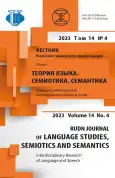Semiotics of Emoticons and Emoji in the Discoursive Space of Spanish Political Internet Communication
- 作者: Larionova M.V.1, Demkina A.V.2
-
隶属关系:
- MGIMO-University
- The Ministry of the Foreign Affairs of the Russian Federation
- 期: 卷 14, 编号 4 (2023): INTERDISCIPLINARY RESEARCH OF LANGUAGE AND SPEECH
- 页面: 1178-1200
- 栏目: SEMIOTICS. SEMANTICS. PAREMIOLOGY
- URL: https://journal-vniispk.ru/2313-2299/article/view/323625
- DOI: https://doi.org/10.22363/2313-2299-2023-14-4-1178-1200
- EDN: https://elibrary.ru/CAUGSW
- ID: 323625
如何引用文章
全文:
详细
The purpose of the study is to establish significance of graphic symbols - semiotic, cognitive and functional characteristics of emoticons and emoji as paralinguistic means of written communication in Spanish political Internet communication. The materials of the study are the publications of Spanish government bodies, political parties and politicians in the official Twitter accounts. The relevance of the study stems from the need to analyze the functional and impact potential of emoticons and emoji as an integral part of modern Spanish political discourse in the Internet and determine their characteristics from the standpoint of theoretical linguistics, discourse theory, semiotics and pragmalinguistics. The paper concludes that the semiotic characteristics of emoji and emoticons as iconic signs and symbols allow them to perform a number of important functions in the discursive Internet communication, for instance, nominative - identifying referents, due to the fact that they are associated with them by physical similarity; syntactic - structuring the punctuation and intonation contour of the message; cognitive - conveying additional conventional meanings implied by the interpretation of the represented objects; communicative - creating an intonation contour and emotional background of the message; influencing - setting the vector of pragmatic interpretation of the message and its empathic component. At the same time, the verbal and non-verbal components of polycode Internet messages are not opposed to each other, but mutually determine the integral perception, representation and interpretation of reality.
作者简介
Marina Larionova
MGIMO-University
Email: larionova.m@list.ru
ORCID iD: 0000-0001-6466-7363
D.Sc. in Philology, Assistant-Professor, Associate Professor of the Department of Spanish Language
76, Vernadsky ave., Moscow, Russian Federation, 119454Anastasia Demkina
The Ministry of the Foreign Affairs of the Russian Federation
编辑信件的主要联系方式.
Email: a.v.dyomkina@yandex.ru
ORCID iD: 0000-0002-3233-8503
SPIN 代码: 4460-2010
Ph.D. in Philology, Third Secretary
32/34 Smolenskaya-Sennaya Square, Moscow, Russian Federation, 119002参考
- Rodríguez, R. & Ureña, D. (2012). Diez razones para el uso de Twitter como herramienta en la comunicación política y electoral. Comunicación y Pluralismo, 5, 89-116.
- Fernández, C.B. & Rodríguez-Virgili, J. (2019). Electors are from Facebook[47], political geeks are from Twitter: Political information consumption in Argentina, Spain and Venezuela. KOME: an International Journal of Pure Communication Inquiry, 7(1), 42-62. https://doi.org/10.17646/KOME.75698.62
- Al-Majdawi, A. & Jabi, S.A (2020). Pragma-Semiotic Analysis of Emoticons in Social Media. Education and Linguistics Research, 6, 139. https://doi.org/10.5296/elr.v6i2.17887
- Danesi, M. (2016). The Semiotics of Emoji. The Rise of Visual Language in the Age of the Internet. London: Bloomsbury Publ.
- Logi, L. & Zappavigna, M. (2021). A social semiotic perspective on emoji: How emoji and language interact to make meaning in digital messages. New Media & Society, 146144482110329. https://doi.org/10.1177/14614448211032965
- Galyashina, E.I. (2022). The Semiotics of Emoticons and Animated Pictures in the Aspect of Forensic Linguistic Expertise. Courier of the Kutafin Moscow State Law University (MSAL), 2(90), 41-48. https://doi.org/10.17803/2311-5998.2022.90.2.041-048 (In Russ.).
- Sampietro, A., Calvo, D. & Campos-Domínguez E. (2020). Los emojis del 8M: Su uso en Twitter durante las movilizaciones feministas de 2019. Dígitos. Revista de Comunicación Digital, 6, 137-158. https://doi.org/10.7203/rd.v1i6.170
- Gallardo Paúls, V., Enguix Oliver, S. & Oleaque Moreno, J.M. (2018). Estilos de gestión de los perfiles políticos en Twitter: imagen y texto en las cuentas de los partidos en la campaña del 26J. Revista de Investigación Lingüística, 21, 15-51.
- Paivio, A. (1986). Mental Represenations: A Dual Coding Approach. Oxford: Oxford University Press.
- Lotman, Yu.M. (2010). Semiosfera. Saint Petersburg: Iskusstvo-SPb. (In Russ.).
- Fauconnier, G. (2002). The Way We Think: Conceptual Blending and the Mind’s Hidden Complexities. New York: Basic Books.
- Kress, G, & Van Leeuwen, T. (1996). Reading Images: The Grammar of Visual Design. New York: Routledge.
- Peirce, Ch.S. (2000). Logical Basis of Semiotic Theory. Saint Petersburg: Aletejya. (In Russ.).
- Brazgovskaya, E.E. (2019). Semiotics. Languages and Cultural Codes. Moscow: Yurajt. (In Russ.).
- Kobrin, N.V. (2015). Role of Hashtags in the Formation of Linguistic Stereotype in Twitter. In: Modern Tendencies of Science and Technology Development: Volume of Materials of VI International Scientific and Practical Conference, 6 (V). Belgorod: IP Tkacheva E.P. pp. 75-78. (In Russ.).
补充文件









